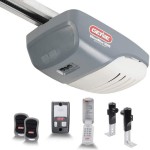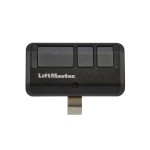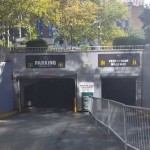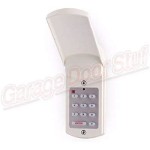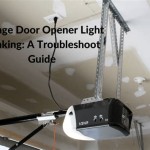Chamberlain Garage Door Opener Flashes 10 Times: Understanding the Issue and Troubleshooting
The Chamberlain garage door opener is a common household appliance designed to provide convenient and secure access to a garage. However, like any mechanical device, it can encounter operational issues. One common issue reported by users is the garage door opener flashing 10 times. This specific flashing pattern is an error code indicating a particular problem within the system. Understanding the meaning of this error code and systematically troubleshooting potential causes is crucial for resolving the issue and restoring the garage door opener to proper functionality.
The flashing LED indicator on a Chamberlain garage door opener serves as a diagnostic tool, communicating specific error conditions to the user. Each number of flashes corresponds to a different issue. When the opener flashes 10 times, it typically signifies a problem with the safety sensors. These sensors, located near the bottom of the door tracks, are designed to detect obstructions in the path of the closing door. If the sensors are misaligned, blocked, or malfunctioning, the opener will stop the door from closing and trigger the 10-flash error code.
Ignoring this error code can lead to further complications. The garage door will likely remain inoperable, potentially compromising security and convenience. Additionally, repeatedly attempting to operate the door while the sensors are malfunctioning can potentially damage the opener mechanism itself. Therefore, a prompt and thorough investigation of the issue is recommended.
Key Point 1: Identifying and Understanding the Safety Sensors
The safety sensors, also known as photo eyes, are a critical component of a modern garage door opener system. They operate on a simple principle: a beam of infrared light is transmitted from one sensor to the other. When this beam is unbroken, the opener is signaled that the path is clear and it is safe to close the door. If the beam is interrupted by an obstruction (a person, object, or even debris), the opener will reverse the door's direction, preventing potential injury or damage.
These sensors are typically small, rectangular units mounted on brackets near the bottom of the garage door tracks, a few inches above the floor. One sensor emits the infrared beam, and the other receives it. The receiving sensor is usually equipped with an LED indicator light that illuminates when it is successfully receiving the beam. This indicator light is a valuable visual aid in troubleshooting sensor problems.
It's important to note that both sensors need to be properly aligned and functioning for the system to operate correctly. Even a slight misalignment can break the infrared beam and trigger the error code. Similarly, any obstruction, even something as small as a spider web or a piece of dirt, can interrupt the beam and cause the issue.
Different models of Chamberlain garage door openers might have slightly different sensor designs, but the underlying principle remains the same. Consulting the owner's manual for a specific model is always recommended to familiarize oneself with the location and appearance of the safety sensors.
Key Point 2: Common Causes of Sensor Malfunctions and Troubleshooting Steps
Several factors can contribute to the safety sensors malfunctioning and causing the 10-flash error. One of the most common is misalignment. The sensors can become misaligned due to accidental bumps, vibrations from the door operating, or even settling of the garage floor. To check for misalignment, visually inspect the sensors. Ensure they are pointing directly at each other and are securely mounted on their brackets. Gently adjust the sensors until the receiving sensor's LED indicator light is illuminated steadily. If the light flickers or remains off, further adjustment may be required.
Another common issue is obstruction. Even small objects can block the infrared beam. Carefully inspect the area between the sensors for any obstructions, such as leaves, dirt, spider webs, or even tools that may have been left in the path. Clean the lenses of the sensors with a soft, dry cloth. Avoid using water or cleaning solutions, as these can damage the sensors. Also, ensure that there are no reflective surfaces near the sensors that might interfere with the infrared beam.
Sometimes, the wiring connecting the sensors to the opener can be the source of the problem. Wires can become loose, damaged, or corroded. Inspect the wiring connections at both the sensors and the opener unit. Ensure that the wires are securely connected and that there are no signs of damage, such as frayed insulation or corrosion. If any damaged wires are found, they should be replaced.
In rare cases, the sensors themselves may be faulty. If the sensors are properly aligned, the lenses are clean, and the wiring is intact, the sensors may need to be tested with a multimeter to check for proper voltage. This is a more advanced troubleshooting step that may require the assistance of a qualified technician.
A power outage or surge can sometimes disrupt the sensor system. Try unplugging the garage door opener for a few minutes and then plugging it back in. This can sometimes reset the system and resolve the issue. However, this is only a temporary solution, and if the underlying problem persists, the error will likely return.
Key Point 3: Addressing More Complex Issues and Seeking Professional Assistance
If the basic troubleshooting steps mentioned above do not resolve the 10-flash error, more complex issues may be at play. For instance, the garage door opener's logic board could be malfunctioning. The logic board is the central control unit of the opener, and it is responsible for processing signals from the sensors and controlling the motor. A faulty logic board may not be able to properly interpret the sensor signals, leading to the error code.
Another potential issue is a problem with the garage door tracks themselves. If the tracks are bent, damaged, or improperly aligned, the door may be binding or encountering excessive resistance. This can put undue strain on the opener motor and potentially trigger the safety sensors. Inspect the tracks carefully for any signs of damage or misalignment. If any issues are found, they should be addressed promptly to prevent further damage to the opener.
In some cases, the problem may not be directly related to the safety sensors but rather to another component of the garage door system. For example, a broken spring, a damaged cable, or a malfunctioning roller can all cause the door to operate improperly and trigger the safety sensors. A comprehensive inspection of the entire garage door system is recommended to identify any potential issues.
When troubleshooting complex issues, it is important to prioritize safety. Never attempt to repair or adjust any components of the garage door system if one is not comfortable working with mechanical and electrical systems. Garage door springs, in particular, are under high tension and can cause serious injury if handled improperly.
If the troubleshooting steps outlined above do not resolve the issue, it is recommended to seek professional assistance from a qualified garage door technician. A technician has the expertise and equipment to diagnose and repair complex problems with garage door openers and safety systems. They can accurately identify the root cause of the 10-flash error and implement the necessary repairs to restore the garage door opener to proper working order. Furthermore, they can ensure that all safety features are functioning correctly, providing peace of mind and preventing potential accidents.
Before calling a technician, it is helpful to gather information about the garage door opener model number and the specific symptoms that are being experienced. This information will help the technician diagnose the problem more efficiently. Also, be prepared to describe the troubleshooting steps that have already been taken.
Regular maintenance of the garage door opener and its components can help prevent future problems. This includes lubricating moving parts, inspecting wiring connections, and ensuring that the safety sensors are properly aligned and free from obstructions. Following the manufacturer's recommendations for maintenance can extend the lifespan of the garage door opener and reduce the likelihood of encountering issues such as the 10-flash error.
Ultimately, understanding the meaning of the 10-flash error code and systematically troubleshooting potential causes is crucial for resolving the issue and restoring the garage door opener to proper functionality. While some issues can be resolved with simple adjustments, more complex problems may require the assistance of a qualified technician. Prioritizing safety and seeking professional help when needed is essential for maintaining a safe and reliable garage door system.

Chamberlain Garage Door Opener Clicks 10 Times Won T Close The Check This Common Problem

How To Fix A Garage Door Opener That Won T Close The Lights Blink 10 Times

Garage Door Won T Close And Light Flashes How To Fix Easy

Garage Door Safety Sensors Troubleshooting Complete 3 Step Guide Youtube

Chamberlain Garage Door Opener Troubleshooting Tips Guide

Chamberlain Garage Door Opener Troubleshooting Tips Guide

Chamberlain 0 75 Hp Myq Battery Backup Belt Garage Door Opener At Lowes Com

Liftmaster 8365 Door Won T Close And Lights Blink Youtube

Top 5 Reasons Why Your Garage Door Opener Is Flashing An Error Code

Reviews For Chamberlain Wall Mount Drive Ultra Quiet Smart Garage Door Opener With Battery Backup And Wifi Connection Pg 1 The Home
See Also

